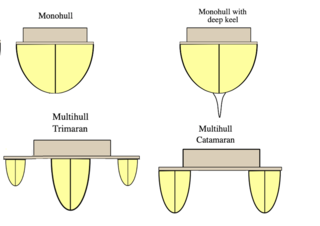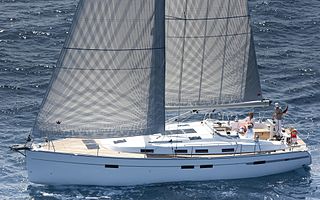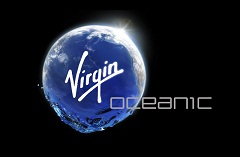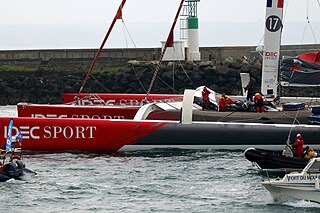Related Research Articles

A multihull is a boat or ship with more than one hull, whereas a vessel with a single hull is a monohull. The most common multihulls are catamarans, and trimarans. There are other types, with four or more hulls, but such examples are very rare and tend to be specialised for particular functions.

Sailing employs the wind—acting on sails, wingsails or kites—to propel a craft on the surface of the water, on ice (iceboat) or on land over a chosen course, which is often part of a larger plan of navigation.

A yacht is a sailing or power vessel used for pleasure, cruising, or racing. There is no standard definition, though the term generally applies to vessels with a cabin intended for overnight use. To be termed a yacht, as opposed to a boat, such a pleasure vessel is likely to be at least 33 feet (10 m) in length and may have been judged to have good aesthetic qualities.

James Stephen Fossett was an American businessman and a record-setting aviator, sailor, and adventurer. He was the first person to fly solo nonstop around the world in a balloon and in a fixed-wing aircraft. He made his fortune in the financial services industry and held world records for five nonstop circumnavigations of the Earth: as a long-distance solo balloonist, as a sailor, and as a solo flight fixed-wing aircraft pilot.

A catamaran is a watercraft with two parallel hulls of equal size. The distance between a catamaran's hulls imparts resistance to rolling and overturning. Catamarans typically have less hull volume, smaller displacement, and shallower draft (draught) than monohulls of comparable length. The two hulls combined also often have a smaller hydrodynamic resistance than comparable monohulls, requiring less propulsive power from either sails or motors. The catamaran's wider stance on the water can reduce both heeling and wave-induced motion, as compared with a monohull, and can give reduced wakes.

A trimaran is a multihull boat that comprises a main hull and two smaller outrigger hulls which are attached to the main hull with lateral beams. Most modern trimarans are sailing yachts designed for recreation or racing; others are ferries or warships. They originated from the traditional double-outrigger hulls of the Austronesian cultures of Maritime Southeast Asia; particularly in the Philippines and Eastern Indonesia, where it remains the dominant hull design of traditional fishing boats. Double-outriggers are derived from the older catamaran and single-outrigger boat designs.

The Jules Verne Trophy is a prize for the fastest circumnavigation of the world by any type of yacht with no restrictions on the size of the crew provided the vessel has registered with the organization and paid an entry fee. A vessel holding the Jules Verne trophy will not necessarily hold the absolute round the world record. The trophy was first awarded to the first yacht which sailed around the world in less than 80 days. The name of the award is a reference to the Jules Verne novel Around the World in Eighty Days in which Phileas Fogg traverses the planet in 80 days. The current holder is IDEC Sport skippered by Francis Joyon in 40 days 23 hours 30 minutes 30 seconds.

Proas are various types of multi-hull outrigger sailboats of the Austronesian peoples. The terms were used for native Austronesian ships in European records during the Colonial era indiscriminately, and thus can confusingly refer to the double-ended single-outrigger boats of Oceania, the double-outrigger boats of Island Southeast Asia, and sometimes ships with no outriggers or sails at all.

Hobie Cat is a company that manufactures watercraft as the Hobie Cat Company. "Hobie Cat" can also refer to specific products of the company, notably its sailing catamarans. Its fiberglass catamaran models range in nominal length between 14 feet (4.3 m) and 18 feet (5.5 m). Rotomolded catamaran models range in length between 12 feet (3.7 m) and 17 feet (5.2 m). Other sailing vessels in the Hobie Cat lineup include, monocats, dinghies, and trimarans, ranging in length between 9 feet (2.7 m) and 20 feet (6.1 m). Its largest product was the Hobie 33, 33 feet (10 m) in length. The company's non-sailing product line includes surfboards, kayaks, stand-up paddle boards, and pedalboards. It was founded in 1961 by Hobart (Hobie) Alter, who originally manufactured surfboards.

A sailing hydrofoil, hydrofoil sailboat, or hydrosail is a sailboat with wing-like foils mounted under the hull. As the craft increases its speed the hydrofoils lift the hull up and out of the water, greatly reducing wetted area, resulting in decreased drag and increased speed. A sailing hydrofoil can achieve speeds exceeding double and in some cases triple the wind speed.

A sailing yacht, is a leisure craft that uses sails as its primary means of propulsion. A yacht may be a sail or power vessel used for pleasure, cruising, or racing. There is no standard definition, so the term applies here to sailing vessels that have a cabin with amenities that accommodate overnight use. To be termed a "yacht", as opposed to a "boat", such a vessel is likely to be at least 33 feet (10 m) in length and have been judged to have good aesthetic qualities. Sailboats that do not accommodate overnight use or are smaller than 30 feet (9.1 m) are not universally called yachts. Sailing yachts in excess of 130 feet (40 m) are generally considered to be superyachts.
Damian Foxall is an Irish sailor from County Kerry.

Virgin Oceanic is an undersea leisure venture of Newport Beach, CA businessman Chris Welsh and Sir Richard Branson, part of Sir Richard Branson's Virgin Group. The brand was first reported in a 2009 Time Magazine interview. The flagship service provided by Virgin Oceanic was intended to take visitors to the deepest parts of the ocean; however, as of late 2014, the project has been put on hold until more suitable technologies are developed.
Daedalus is a maxi-catamaran, that participated in numerous open-ocean races under various owners and names.

The first around the world sailing record for circumnavigation of the world can be attributed to the surviving crew of Ferdinand Magellan's expedition, including the last captain Juan Sebastián Elcano who completed their journey in 1522.
VPLP design is a French-based naval architectural firm founded by Marc Van Peteghem and Vincent Lauriot-Prévost, responsible for designing some of the world's most innovative racing boats. Their designs presently hold many of the World Speed Sailing records.
DeepFlight Challenger is a one-person submersible built with the intention of reaching the Challenger Deep, utilizing DeepFlight technology from Hawkes Ocean Technologies. The submersible is owned by Virgin Oceanic.
James Wharram was a British multihull pioneer and designer of catamarans.

The Nacra 17 is a performance catamaran used for sailing. It was designed in 2011, went into production in 2012 and has been the focus of multihull sailing at the Olympic Games since its conception.

The Newport to Ensenada Yacht Race is an annual 125-nautical-mile international yacht race. First run in 1948, sailors gather each spring in Newport Beach, California, to participate in one of the West Coast's premier regattas. The Newport to Ensenada yacht Race (N2E) is a race to the city of Ensenada, Baja California.
References
- 1 2 "PlayStation 125 - Records >> Morrelli & Melvin | Multihull Design * Engineering * Brokerage". www.morrellimelvin.com. Retrieved 1 June 2021.
- ↑ Zimmermann, Tim (8 April 2011). "Cheyenne Rides Again". Sailing World. Archived from the original on 18 August 2016. Retrieved 1 June 2021.
- ↑ Honey, Sally Lindsay, ed. (2015). SAFETY AT SEA CORE TOPICS HANDBOOK (PDF). United States: US Sailing. pp. 139–140. Archived from the original (PDF) on 16 October 2018.
- ↑ "STEVE FOSSETT CHEYENNE CATAMARAN AND THE JULES VERNE TROPHY AROUND THE WORLD IN 58 DAYS 9 HOURS". Solarnavigator.net. 1 March 2005. Retrieved 2 July 2015.
- 1 2 Rohit, Parimal M. (4 December 2014). "Time is running out for Cheyenne – The Log". The Log. Archived from the original on 4 August 2020. Retrieved 1 June 2021.
- ↑ Archived 27 September 2011 at the Wayback Machine
- 1 2 Archived 8 October 2011 at the Wayback Machine
- 1 2 "/ SUB". 2011. Archived from the original on 7 August 2011. Retrieved 1 June 2021.
{{cite web}}: More than one of|archiveurl=and|archive-url=specified (help) - ↑ Archived 15 October 2011 at the Wayback Machine
- ↑ "Amendment to WSSR Newsletter No 122". Sailspeedrecords.com. 24 July 2006. Retrieved 2 July 2015.
- ↑ Archived 27 September 2011 at the Wayback Machine